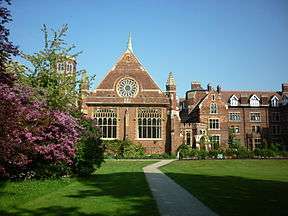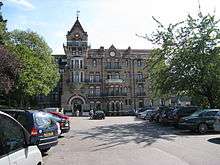John Giles (architect)
| John Giles | |
|---|---|
 Langham Hotel (1865) | |
| Born |
?1830 Lincoln |
| Died |
20 February 1900[1] 42, Bedford Square, London. |
| Occupation | Architect |
| Practice |
John Giles & Gough Giles, Gough & Trollope |
| Buildings |
St Augustine's Hospital, Chartham Langham Hotel, London Christ Church, Gipsy Hill |
John Giles was a British architect. He was born in Lincoln probably in 1830, and articled to the Lincoln architect Pearson Bellamy.[2]
Works
Giles initially worked with Bellamy and Hardy of Lincoln. In 1859 they submitted plans in a competition for the Manchester Assize Courts in Great Ducie St. Manchester, but the competition was won by Sir Alfred Waterhouse with a notable building in the Venetian Gothic. Giles and Bellamy and Hardy's proposed building was in the Palazzo revival style. Then in 1861 they were successful in a competition to design the Town Hall at Grimsby. Giles' practice was first at 2 Verulam Buildings, London in 1864 and he was to move to 28 Craven Street, Charing Cross by 1868. A notable architect articled to Giles was Charles Bell who came from Grantham in Lincolnshire. Following this Giles was working by himself and his most notable buildings were:
- Langham Hotel, London, built between 1863 and 1865,[3]
.jpg)
- Petersham Hotel, Petersham completed in 1865.
.jpg)
- Hillfield House, Gloucester, built in 1867-9 for the timber merchant Charles Walker. A mansion faced in ashlar Bath stone. It is in the Italianate style popularised by Charles Barry with a centrally placed tower and an impressive porte-cochère entrance. Pevesner describes it as the ‘‘most elaborate Victorian house in Gloucester’’. It is now local government offices. [5]
Giles and Angell
.jpg)
For a short time he worked with Lewis Angell, who was the District Surveyor for West Ham. They submitted a design for Stratford Town Hall (now known as Stratford Old Town Hall), beating thirty competing entries. The building was completed in 1869 and extended by Angell in 1881.[6] The building is described as a confidently Victorian version of arched Cinquecentowith rusticated stone ground floor with square headed window openings beneath an upper storey of round arched windows, divided by Corinthian columns. Carried off with considerable panache with an asymmetrical 100ft domed tower. The balustraded parapets are decorated with allegorical figures. [7]
Giles and Biven
By 1866 Giles was in partnership with Edward Biven at 28 Craven Street, when they designed an Infirmary for for the St. Pancras Guardians of the Poor. This building is now part of the Highgate Wing of the Whittington Hospital.
Giles and Gough

By 1873 Giles was in partnership with Albert Edward Gough (died 1908) at Craven Street The partnership increasing specialised in asylum, hospital and workhouse architecture. Work by them includes:
- They designed the extension wings to the Georgian workhouse in Cleveland Street, London in 1873[8]
- Cavendish College, Cambridge (now part of Homerton College) in 1876-8.[9] Homerton College, from London, moved into the buildings in1894. Large, red-brick, Tudor, with asymmetricalGothic tower, and Gothic Hall windows.[10]
- Christ Church, Gipsy Hill, London
- New End Hospital, Hampstead.[11]
Giles, Gough and Trollope.
By 1888 Giles and Gough were joined by John Evelyn Trollope, an architect who had trained under Sir Arthur William Blomfield. Trollope was to continue the practice at 28 Craven Street after Gough's death in 1908. Trollope died in 1912.[12] The practice expanded considerably at this time, particular building hospitals and mental asylums. Also they built housing in London, in the Queen Anne revival style, normally in red brick and using terracotta decorative panels. Much of this housing appears to have been designed by John Evelyn Trollope.
Giles and the Building of Mental Asylums
.jpg)
Following Giles' innovative design for the Coney Hill mental hospital in Gloucestershire, Giles became one of the most successful asylum architects winning eight of the sixteen competitions he entered and coming second in four. Examples of work undertaken by his partnership are:
- Coney Hill Hospital, Gloucester. Built as the second Gloucestereshire County Asylum. Giles and Gough won a competition to build this in 1879 and it was built in 1881-3. It was the first asylum to be built in true echelonplan [13] , but was never fully completed. Only the administrative block now survives. [14][15]
- St Augustine's Hospital, Chartham, Kent. The asylum was opened on 5th April 1875 The buildings were completed in 1876 at a total cost of £211,852. Originally built to house 870 patients.
- St. Edward’s Hospital, Cheddeleton, Staffordshire. (Giles, Gough and Trollope) Opened 18th August 1899. Echelon layout. It closed in 2002 and has now been converted to housing.
- Tone Vale Asylum, Cotford, Somerset.
- Talgarth Hospital, Powys.The building, designed by Messrs Giles, Gough and Trollope of London followed the compact echelon or arrow plan and was built at a cost of £126,000. It was opened with public ceremony on March 18, 1903 [16]
Gallery
- Buildings by John Giles
.jpg) Town Hall, Grimsby (1861-3)
Town Hall, Grimsby (1861-3) Petersham Hotel, Petersham, London (1865)
Petersham Hotel, Petersham, London (1865)_2012.jpg) Cavendish Building, Homerton College, Cambridge (1878)
Cavendish Building, Homerton College, Cambridge (1878)
References
- ↑ "Re John Giles, Deceased". The London Gazette (27184): 2570. 20 April 1900.
- ↑ The 1851 Census notes that John Giles, aged 21 and born in Lincoln, was a lodger with Pearson Bellamy in Melville Street, Lincoln
- ↑ "1863 – The Langham Hotel, Portland Place, London". Retrieved 12 March 2014.
- ↑ Cloake, John. "History of The Petersham Hotel Richmond". Retrieved 11 March 2014.
- ↑ Verey D. and Brooks A.(2002), ‘‘The Buildings of England: Gloucestershire2:The Vale and Forest of Dean’’, pg.501.
- ↑ "1869 – Public Office & Vestry Hall, Stratford, London". Retrieved 12 March 2014.
- ↑ Cherry B et al (2005), Buildings of England: London 5: East pg 226
- ↑ "Giles & Gough – Architects". The Cleveland Street Workhouse. January 2011. Retrieved 7 May 2014.
- ↑ "1878 – Cavendish College, Cambridge, Cambridgeshire". Retrieved 12 March 2014.
- ↑ Pevsner N (2nd ed. 1970), The Buildings of England, pg.234.
- ↑ "Giles & Gough – Architects". Retrieved 12 March 2014.
- ↑ "Brodie", (2001), Vol. 2, pg.836
- ↑ "Goodall et al", (1998", pg 174,fig 174 B)
- ↑ Verey D. and Brooks A.(2002), ‘‘The Buildings of England: Gloucestershire2:The Vale and Forest of Dean’’, pg.465.
- ↑
- ↑ Save
Further reading
- Antonia Brodie (ed) Directory of British Architects, 1834–1914: 2 Vols, vol. 1, pg.725 British Architectural Library, Royal Institute of British Architects, 2001.
- Goodall I. et al.(1998), English Hospitals 1660-1948 : A Survey of their Architecture and Design, RCHME, ISBN 187735922999
Internet Sources
| Wikimedia Commons has media related to John Giles (architect). |